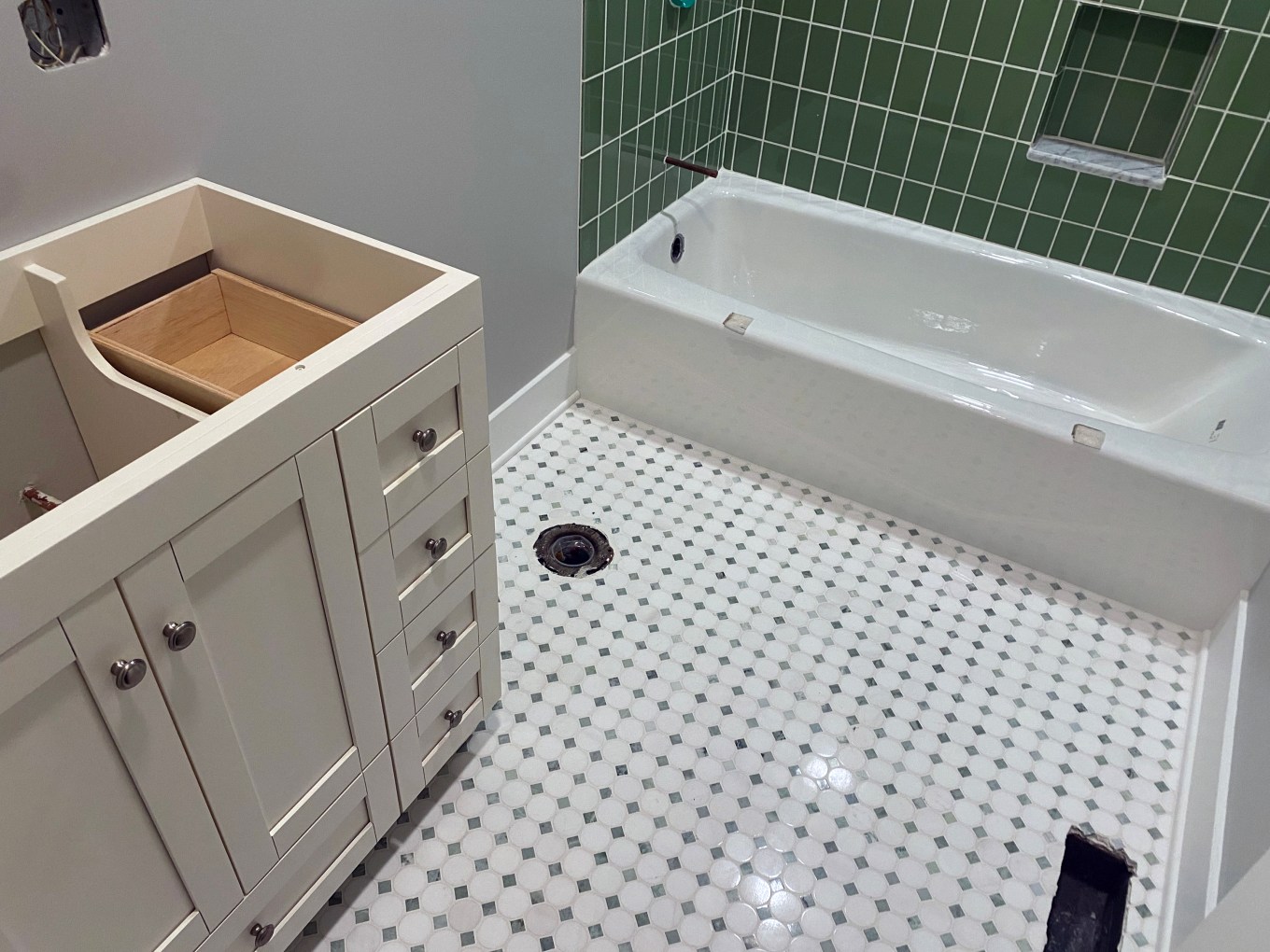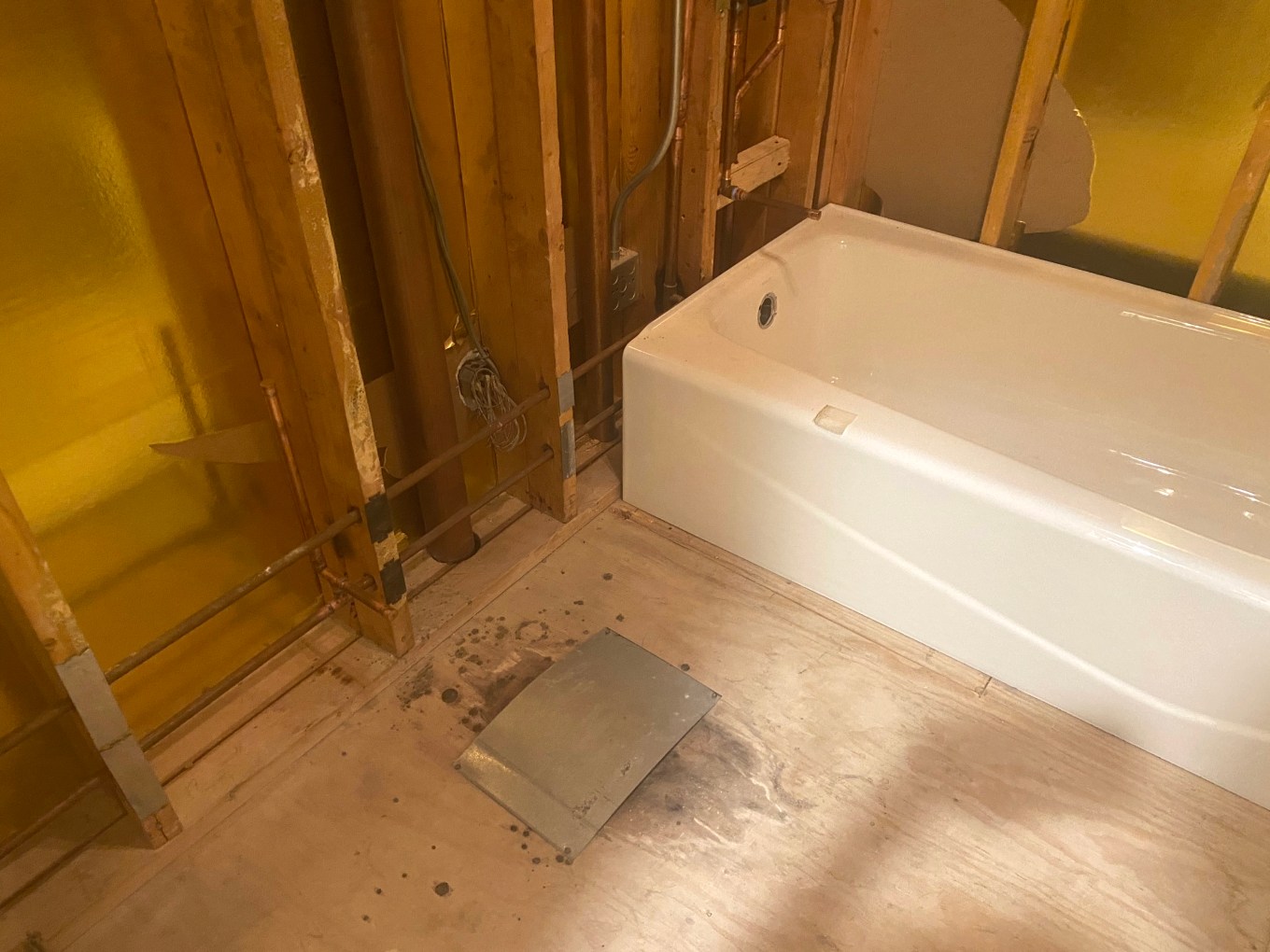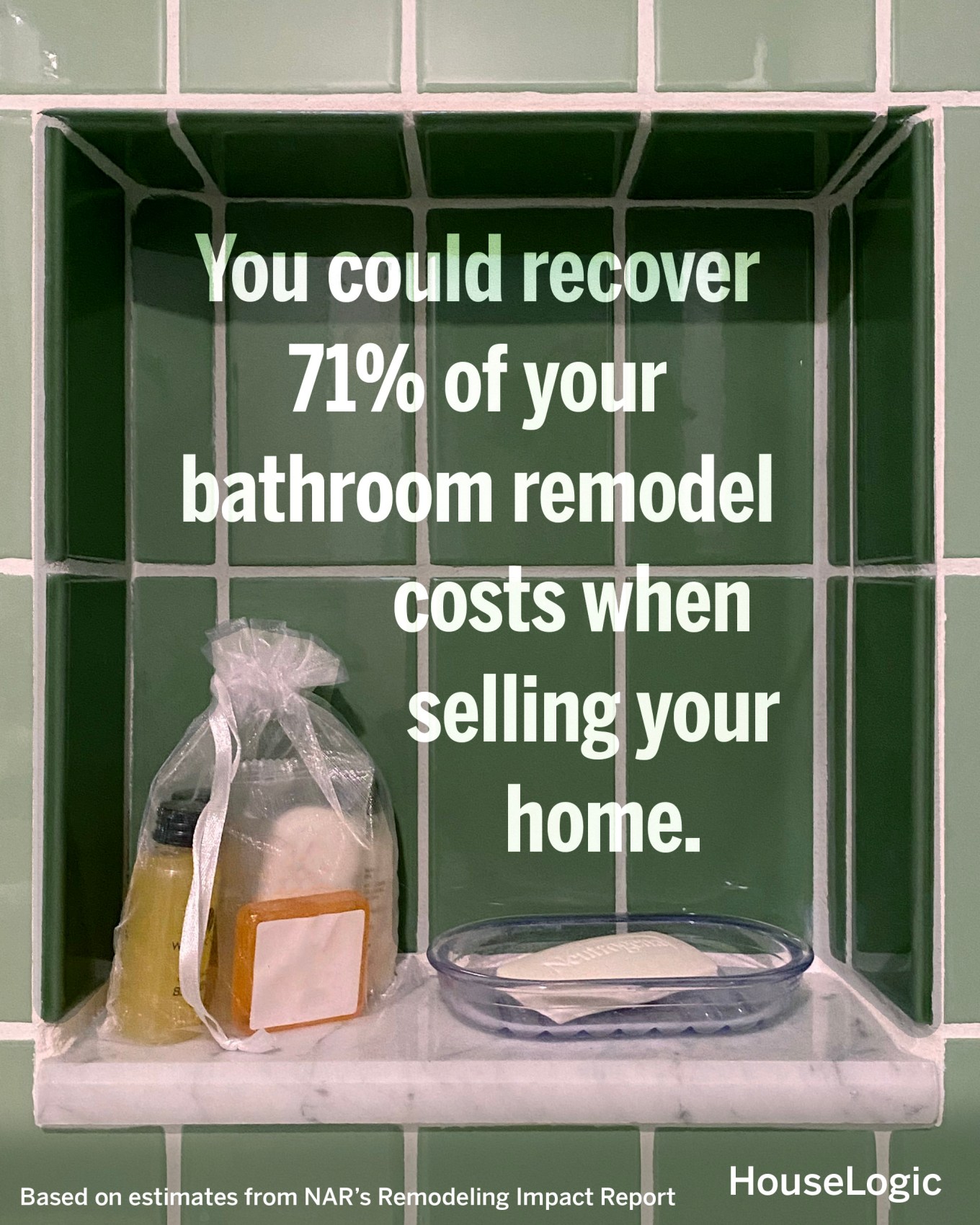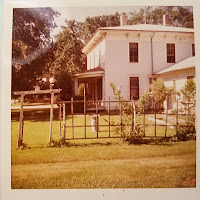If you are looking to sell, or if you're a buyer who found the right home but it needs a bathroom refresh, you might find the help you're looking for in this article:
Looking for a refresh or an overhaul? Either way a bathroom remodel could be just the thing to boost home value and your enjoyment of the space.
 |
| Image:Maggie Stuart|HouseLogic |



Many homeowners are excited to turn their bathrooms into a spa-like oasis with exciting upgrades. But before starting an ambitious remodel, it helps to understand the costs of such a project. Let’s review various factors in bathroom remodeling and the associated costs.
Factors Influencing Bathroom Remodel Costs
Remodeling costs vary based on components like location, labor, and the size and style of the space. Here are a few factors to consider.
Size and Scope of Your Bathroom Remodel
Size – the square footage involved – is self-explanatory. The scope of your project could include existing plumbing, the difficulty of demolition, the floor plan and layout, the number of upgrades and fixtures, and the doors and windows. Problems that require repair (such as water damage) may add to your costs. A complex project with many changes will cost more than a few surface-level or small-scale changes.
Permits and Regulatory Costs
Permit requirements vary by location. Check with local authorities about county or municipal codes and get an understanding of current permit costs. You may need to factor in $150 to $1,000 for permit costs based on location and project. A contractor can also tell you whether your remodel requires a permit.
Labor and Materials
Labor is one of the primary costs associated with a remodel, and rates can vary based on where you live. Interviewing a few contractors in your area will help you plan your labor budget. For a basic bathroom remodel with about 50 hours of labor, expect costs to start at $4,000. For a major bathroom renovation and about 90 hours of labor, expect to pay up to $11,200. The materials also affect the cost of your remodel. Certain materials – like natural stone or quartz countertops, brass faucets, or heated flooring – can make your bathroom look more luxurious, but they may also drive up the price of the project.
Types of Bathroom Remodels
Identifying the depth of changes you’re planning can help you budget for your remodel.
Levels of Bathroom Remodeling
Let’s review a few levels of bathroom remodeling. Your project may not fit easily into just one level, but this offers a look at the options.
- Cosmetic upgrade: Involves changing fixtures, updating paint, replacing hardware, installing new lighting, and adding accessories.
- Tile and flooring update: Focuses on changing the flooring and/or wall tiles, which can significantly alter the aesthetics of the bathroom.
- Plumbing and electrical updates: Can include updating or relocating plumbing and electrical components to improved functionality and efficiency.
- Luxury remodel: Covers everything from chic changes to updates focused on comfort. It may include installing premium fixtures, using high-end materials, adding luxury amenities like a spa tub, or incorporating advanced smart home features.
- Mid-level remodel: Includes both cosmetic and functional upgrades, often involving updating fixtures, changing the layout, installing new flooring and tiles, and revamping plumbing and electrical systems.
- Complete gut and remodel: Requires demolition of the existing space and rebuilding from scratch.
Bathroom Remodel vs. Bathroom Renovation
While the terms “remodel” and “renovation” are often used interchangeably, each has a distinct meaning. A renovation implies a refresh. It may involve repairing or restoring existing elements of your bathroom with cosmetic upgrades. Remodeling implies a deeper level of changes including structural changes, new installations, or a total redesign.
Key Design Elements of a Bathroom Remodel: Costs
Certain design elements of your bathroom can make a big visual impact. Here’s a breakdown of some of the costs associated with these upgrades.
Vanity and Cabinets
Installation of a bathroom vanity can cost $565 to $839, according to Homewyse. These are rough estimates that would be affected by your location and the materials you select. The average cost of refinishing bathroom cabinets ranges from $6.85 to $15 per square foot.
Flooring
The average cost to replace a basic ceramic floor in a 50-square-foot bathroom is roughly $500. However, most bathroom floor replacements cost $250 to $2,500. If you uncover mold or other issues during the remodel, costs will increase.
Ceramic tiles are easy to maintain but can get chilly. At $8 to $15 per square foot to install, radiant mats are a cost-effective option.
Fixtures: Sinks, Faucets, and Toilets
The cost to buy and install faucets typically falls between $225 and $475. For sinks, expect to pay $300 to $5,500, and for toilets, you may spend $350 to $3,500.
Lighting
Lighting can make or break a space and is a key functional aspect of a bathroom. If you're seeking budget-friendly lighting options, a small change can make a big difference. For example, updating the color temperature of the bulbs can quickly warm up the space. For a bigger impact, you might change the fixtures. Homeowners may spend $1,709 to $2,071 on their bathroom light fixtures and installation, according to Homewyse.
Tub and Shower
Shifting your shower plumbing to a different spot in the bathroom can cost as much as $4,100, and purchasing and installing new shower fixtures range from $1,500 to $3,500. Installing a new tub ranges from $1,500 to $2,900.
Tiles and Backsplashes
Updating the tiles in your bathroom can transform the look of the space. Fancy tiles enhance your bathroom’s appearance and contribute to a spa-like feel. Your tile expenses will depend on your project. Some homeowners prefer to stick with tile in the shower; others may use tile for only the floor. Inexpensive tile options like ceramic and porcelain cost $10 to $44 per square foot, including installation. Glass tiles are pricier, at $27 to $114.
Bathroom Remodel Costs Based on Size and Type
The number of components and the size of your bathroom will inform the cost of your remodel. A full bathroom includes four main components: a bathtub, a shower, a toilet, and a sink.
Powder Rooms or Half Bathrooms
A powder room or half bath usually includes just a toilet and a sink. Fewer components may mean these bathrooms are less expensive to remodel than their larger counterparts. You could pay $1,200 to $4,000 for a half-bath remodel.
Three-Quarter Bathrooms
This bathroom style typically includes a shower or bathtub, a toilet, and a sink. Remodeling costs range from $3,125 to $6,000.
Full Bathrooms
Full baths vary in style and size but in general, a full bathroom remodel costs $5,250 to $16,000, while a partial remodel costs $3,500 to $12,000.
Bathroom Remodel Project Cost by Project Scope
Homeowners can determine the complexity and breadth of their project based on their budget.
Low-Cost Projects
A one-day remodel could give your bathroom a fresh new look without a big price tag. For this type of project, expect to pay as little as $3,000. Consider updates like surface liners on your tub and shower that can visually refresh your bathroom.
Mid-Range Projects
The average cost of a partial bathroom remodel with new flooring and fixtures and some design updates is $5,000 to $15,000.
High-End Projects
Lavish bathrooms with plenty of space and high-end fixtures and finishes come with a steeper price tag. Expect to shell out $27,500 to $100,000 for luxury remodels.
Successfully Navigating Bathroom Remodel Costs
The level of bathroom remodel you choose will depend on your goals, budget, and the condition of your existing space. It’s a good idea to compare price quotes and material costs, develop a clear project plan, and work on a flexible budget before taking on a bathroom remodel.
Bathroom Remodel Cost Frequently Asked Questions
Can I DIY a Bathroom Remodel to Save Money?
If you have renovation and construction experience, you may be equipped to execute a bathroom remodel. But you need to be well versed in the trades and understand local regulations and permits. Performing tasks like painting and decorating could help lower costs, but it's best to leave complex remodel tasks to the pros if you aren’t experienced.
When Should I Hire a Professional?
For complex projects with structural changes or plumbing or electrical work, consider hiring a professional, who is more likely to do the work safely and up to code. Professionals bring specialized knowledge and skills and are used to tight schedules. They can often complete the project more quickly than DIYers, especially if surprises or issues arise.
How Do I Budget for Unexpected Bathroom Remodeling Expenses
When you budget for your bathroom remodel, identify potential problems such as plumbing, electrical, or structural concerns. Look up common challenges associated with bathroom remodels and assess your space for those issues. Get opinions and quotes from multiple contractors and choose the best option. Lastly, set aside a contingency fund for unexpected expenses.
What’s the ROI of a Bathroom Remodel?
The National Association of REALTORS® 2025 "Remodeling Impact Report" estimated that homeowners would recover about 50% of the value of their bathroom remodeling investment. In the past two years, real estate agents have seen a 35% increase in the demand for bathroom renovation. In addition, 24% of real estate agents recommend sellers remodel the bathroom before selling. Consider high-ROI projects like accessibility modifications, new flooring, or a tub/shower upgrade.
How Long Does a Bathroom Remodel Typically Take?
Cosmetic upgrades may take a few days to a week. Extensive remodeling work can take several weeks or a few months. The availability of materials, the speed of contractors, and adherence to the project timeline all contribute to the overall time frame. Talk to your contractor about timelines and factor in a buffer period of a week or two when figuring when you’ll have use of your bathroom again.
Julia Huntsman, REALTOR, Broker | http://www.abodes.realestate | 562-896-2609 | California Lic. #01188996














